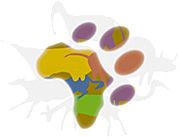
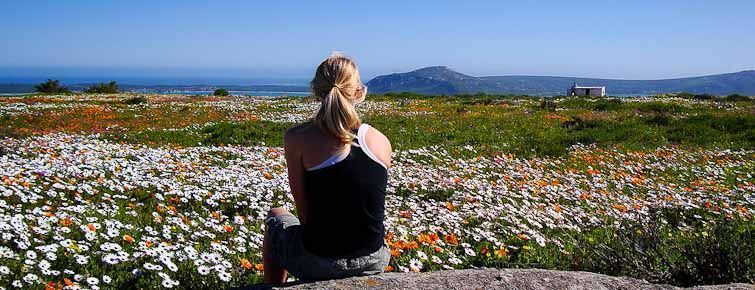
The West Coast
east vs west coast
South Africa lies at the southern tip of the African continent, with a coastline in excess of 2500km / 1500mi in length. The eastern seaboard features a mostly sub-tropical climate, due to the influence of the warm Mozambiquen (ocean) Current. The western seaboard, known as The West Coast is influenced by the cold Benguela Current and is thus more arid. The West Coast’s marine life is also markedly different due to the colder water temperatures.
vegetation
Strictly speaking Cape Town lies on the West Coast, but when South Africans refer to The West Coast we are referring to everything going up the western coastline outside of Cape Town. Leaving Cape Town along the western coastline one encounters typical Fynbos shrubland and inland incursions of sea sand - both dunes and sandy shallows interspersed with coastal woodlands. As you work your way up to Namibia, South Africa’s north-western neighbour, the coastline gradually becomes drier and more arid still, until it eventually turns to desert.
traveling up the coast
Venturing out of Cape Town the coastal (secondary) R(oute)27 stays close to the coastline as it knits together the decidedly attractive coastal urban sprawl of the ’Mother City’, initially with views of Table Mountain across Table Bay, all the way to Melkbosstrand, 27km from the CBD. From here on the R27 stays just inland from the coast with one or two little hamlets a turn-off and a few minute’s drive away - e.g. Grotto Bay and Yzerfontein.
Arguably the most popular and worthwhile destinations on the West Coast, depending on your preferences, lie just beyond Yzerfontein on the ’West Coast Peninsula’ - a stump-nosed area of land protruding from the coastline westward. Destinations include from south to north the West Coast National Park, the Langebaan Lagoon, the town of Langebaan, Club Mykonos, Saldanha Bay and town (even though it includes an unsightly iron ore export terminal), Jacob’s Bay, the desolate Cape Columbine Reserve (including Tieties Baai & the Cape Columbine Lighthouse) and next-door Paternoster with the Peninsula tapering of to Shelley Point (a private golf-estate-hotel development), St. Helena and Velddrif at the mouth of the Bergrivier (Berg River). The Peninsula is a 60-90 minute drive from Cape Town depending on which section you go to and it’s easy to reach all the attractions within the Peninsula from one another.
Once you leave the Peninsula you’re forced to travel via the inland N7, which links Cape Town with the Namibian border to the north. From here onwards destinations are few and far between and reaching them means journeying to the coast from arterial roads branching off the N7. Going north perhaps the most accessible destination on the coast is Lambert’s Bay, where the Muisbosskerm (informal branch enclosure) seafood restaurant on the beach is a must-do experience.
combine with the interior
Inland from the West Coast you’ll find fascinating regions that combine very well with the former, either as a circular route anchored by Cape Town or on your way somewhere else. These include the Swartland (featuring wheat fields and nature) and the Cederberg. The latter is home to South Africa’s rooibos tea industry (red bush tea) and the magnificent Cederberg Mountains.
Tours that include The West Coast
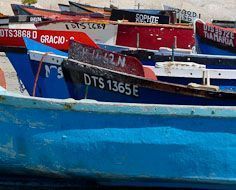
West Coast and Winelands Scheduled Tour
Duration: 4 days, 3 nightsTour Type: Scheduled tours
Luxury Level: ***
Price: R10,945 per person sharing (±US$ 789 )
R250 single supplement (±US$ 18 )
Valid dates: Feb 2015 - Oct 2015
This tour gives you the opportunity to visit the Cape Winelands, taste some of our best estate wines and experience the special kind of West Coast hospitality and cuisine. Visit two factories at Clanwilliam producing two quintessential South African products: velskoene and rooibos tea. Overnight at the quaint Paternoster. Visit Saldanha Bay harbour and the West Coast National Park. In season you might enjoy vast expanses of indigenous flowers.
Highlights:
Cape Winelands
,
Riebeek Valley
,
Paternoster
,
The West Coast
,
Cederberg Mountains & Wilderness Area
,
Bird Island Nature Reserve
.
The West Coast attractions
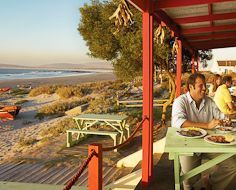
Paternoster
Paternoster, a small fishing village situated on the West Coast, is a popular weekend destination for Capetonians. The name Paternoster refers to the “our Father” prayer of Portuguese sailors who were shipwrecked in the area. The town is famous for its abundance of crayfish, its traditional fisherman's architecture and endless pristine sandy beaches.
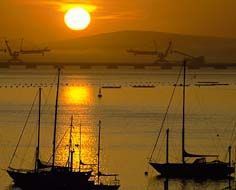
Saldanha Bay
The seaside village of Saldanha bay is situated on the northern end of Saldanha Bay on the Cape West Coast in South Africa. The Bay is the largest bay on the South African Coast and a centre for nature conservation and eco tourism.
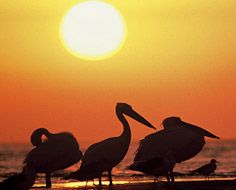
Lambert’s Bay
Lambert’s Bay is a small ‘fishing’ village on the West Coast of South Africa ±250km north of Cape Town. The northern gateway to the Cederberg Mountains, Clanwilliam, is a 30-minute drive away. It is best known for Bird Island featuring thousands of Cape Gannet and for the Muisbosskerm seafood-on-the-beach restaurant.
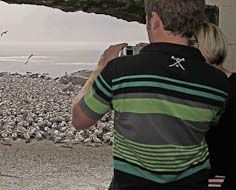
Bird Island (West Coast)
Bird Island Nature Reserve lies offshore from Lambert’s Bay ±241 north of Cape Town. Visitors access the island either via the breakwater or a short boat hop. It is home to thousands of seabirds that breed there. The Island’s bird hide allows close-up observations of the birds.
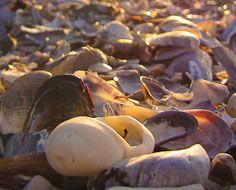
Cape Columbine Nature Reserve
The Cape Columbine Nature Reserve (263ha) is located on the West Coast Peninsula adjacent to Paternoster. It’s is best known for the Cape Columbine Lighthouse (1936) and Tietiesbaai. Visitors can tour and ascend the lighthouse. The Reserve offers three basic accommodation options. Cape Columbine feature rocky coastline with small coves.
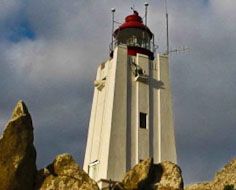
Cape Columbine Lighthouse
The Cape Columbine Lighthouse (1936) is popular with travellers heading to Paternoster on the West Coast Peninsula. Visitors can tour the lighthouse and ascend the spiral staircase to the top, where the light stands at a height of 80m above sea level and casts a beam visible for about 50km.
